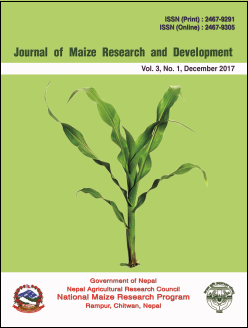Analysis of genetic diversity among the maize inbred lines (Zea mays L.) under heat stress condition
DOI:
https://doi.org/10.3126/jmrd.v3i1.18925Keywords:
Maize (Zea mays L.), Genetic divergence, Heat stress, Multivariable analysisAbstract
High temperature adversely affects the plant physiological processes: limits plant growth and reduction in grain yield. Heat stress is often encountered to spring sowing of maize in spring season. Twenty maize inbred lines were studied for days to 50 % anthesis and silking, anthesis–silking interval, leaf firing, tassel blast, SPAD reading and leaf senescence, plant and ear height, leaf area index, ear per plant, cob length and diameter, number of kernel/ear, number of kernel row/ear, number of kernel row, silk receptivity, shelling percentage, thousand kernel weight and grain yield in alpha lattice design at National Maize Research Program at Rampur, Chitwan,Nepal with the objective to identify superior heat stress tolerant lines. Analysis of variance showed significant difference for all the traits. Result of multivariable analysis revealed that twenty inbred lines formed four clusters. The resistance inbred lines and susceptible inbred lines formed different clusters. The members of cluster 4 were found to be tolerant to heat stress due to they had lowest value of tassel blast, leaf firing, and leaf area index with highest value of cob diameter and length, ear per plant, number of kernel row/ear, number of kernel/ear, number of kernel row, shelling percentage, silk receptivity and grain yield whereas as members of cluster 1were found most susceptible due to they had longer anthesis silking interval, with maximum tassel blast and leaf firing along with no grain yield under heat stress condition. From this study inbred lines RL-140, RML-76, RML-91 and RML-40 were found most tolerant to heat stress. These inbred lines belonging to superior cluster could be considered very useful in developing heat tolerant variety and other breeding activities.




